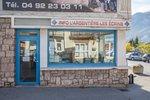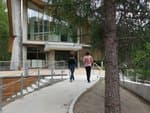Maxi Goureng (trail route no. 14)
“ Descending from the Col de Val Haute into the secret valley of Font Cailla, under the cliffs of the Tête de Gaulent, is a thrilling moment. Here, you are only likely to meet a shepherd and his flock, depending on the season. ” Marie-Geneviève Nicolas, park ranger at the Parc National des Écrins
Description
Go up through the village of Freissinières following signs for Les Roberts and Les Aujards. Then continue on the path leading to Le Clot du Puy and the Col de l'Aiguille. A steep descent brings you back to the hamlet of Pallon.
- Cross the bridge over the Biaysse and go up a lane opposite, which will turn into a track.
- At the hamlet of Le Serre, turn left between two houses onto the path leading to Les Seyes. From this hamlet, head towards Clot Lafont. The path rises for a long stretch through the forest and, after a steeper section, comes out into the alpine pasture of Clot Lafont. Carry on until you come to the Col de Tramouillon. Head downhill towards the Cabane de Tramouillon.
- Make a there-and-back detour to visit the cabin.
- Take a path on the left which passes close to the Cabane de l'Essaumaure. Climb uphill again until you come to the Col de Val Haute. Drop down through the valley of Font Cailla and take a path leading away across the hillside to join the farm track to Le Lauzet. Follow this path along a long traverse and then follow the downhill track to the park cabin ("Cabane du Parc") and Freissinières (paths cutting across the sharp bends) which brings you back to the valley bottom. You reach Freissinières via a track running along the right-hand bank of the Biaysse.
- Departure : Valley Centre ("Maison de la Vallée"), Freissinières
- Arrival : Valley Centre ("Maison de la Vallée"), Freissinières
- Towns crossed : Freissinières and Champcella
Altimetric profile
Recommandations
Before setting off, it is very important to check the opening periods for this route on the website: https://stationdetrail.com/fr/stations/le-pays-des-ecrins/parcours
Share your photographs on social networks with #stationdetrailecrins
Check weather conditions before setting off.
Rescue services contact details: Secours Montagne (Mountain Rescue): +33 (0)4 92 22 22 22 or 112
Show consideration for the work of farmers, livestock keepers and owners
Close all gates behind you
Take your litter home
Do not take shortcuts across pastureland
The trail routes are also suitable for walking
Information desks
23 Avenue de la République, 05120 L'Argentière-La Bessée
Vallouise Park house
, 05290 Vallouise
Information, documentation, models, exhibitions, screenings, product sales and works of the Park. Guided tours for school, reservation required. The new Park House opened in Vallouise since June 1, and offers visitors an interactive permanent exhibition inviting to explore the area and its heritage. A temporary exhibition space will allow a renewed offer. Finally, the device is completed by an audiovisual room to organize screenings and conferences Free admission. All animations of the Park are free unless otherwise stated.
Transport
Public transport >> www.pacamobilite.fr
Consider car-sharing >> www.blablacar.fr
For more information, ask at the Tourist Information Office nearest to the trail starting point.
Access and parking
11.5 km from L'Argentière-La Bessée, take the N94 and the D38.
Parking :
Sensitive areas
Alpine ibex
- Impacted practices:
- Aerial, , Land, Vertical
- Sensitivity periods:
- JunJulAugSep
- Contact:
- Parc National des Écrins
Julien Charron
julien.charron@ecrins-parcnational.fr
Golden eagle
- Impacted practices:
- Aerial, , Vertical
- Sensitivity periods:
- JanFebMarAprMayJunJulAug
- Contact:
- Parc National des Écrins
Julien Charron
julien.charron@ecrins-parcnational.fr
Golden eagle
- Impacted practices:
- Aerial, , Vertical
- Sensitivity periods:
- JanFebMarAprMayJunJulAug
- Contact:
- Parc National des Écrins
Julien Charron
julien.charron@ecrins-parcnational.fr
Golden eagle
- Impacted practices:
- Aerial, , Vertical
- Sensitivity periods:
- JanFebMarAprMayJunJulAug
- Contact:
- Parc National des Écrins
Julien Charron
julien.charron@ecrins-parcnational.fr
Peregrine falcon
- Impacted practices:
- Aerial, Vertical
- Sensitivity periods:
- FebMarAprMayJun
- Contact:
- Parc National des Écrins
Julien Charron
julien.charron@ecrins-parcnational.fr
16 points of interest
 Vernacular heritage
Vernacular heritageThe church of Sainte Marie-Madeleine
The church of Sainte Marie-Madeleine was built in the seventeenth century. It is thought to be a former Protestant church which escaped destruction in 1684 when Louis XIV was leading an anti-Protestant drive. The Protestant church is then thought to have undergone works to convert it into a Catholic church.
 History
HistoryFélix Neff
Félix Neff was a Swiss Protestant pastor. He was responsible for the Protestant Revival in the Freissinières valley in the seventeenth century. He also set up the first education college for primary school teachers in France, in Dormillouse in 1826. He was also behind new irrigation and house-building techniques, developments which improved the everyday lives of the local people.
 Fauna
FaunaThe common redstart
The common redstart can be told apart from its cousin, the black redstart by its white eyebrow (hence its French name which is translated as "white-browed redstart") and its orange breast. At least for the male, since the female of both birds is duller and brownish, but the female common redstart also has an orangey tail. It returns from Africa in early April and searches the areas to find a hollow in a tree or in an old wall where it builds its nest.
 Fauna
FaunaThe scarce swallowtail
A large pale yellow butterfly with black stripes flutters from bush to bush. There is a "tail" at the tips of the posterior wings, marked with an orange and blue blotch. The scarce swallowtail lives in hot, dry environments. It favours uncultivated land where blackthorn and hawthorn grow, on which the female lays her eggs and where the caterpillars develop.
 History
HistoryThe Grotte des Vaudois - The Waldensians' Cave
The history of Freissinières is linked to that of the Waldensians, who found refuge in this valley and in other Alpine valleys in the thirteenth century. The followers of this religious movement - which later embraced the reformation - were deemed to be heretics and therefore persecuted. This cave, in which Waldensians sought refuge after being taken by surprise, witnessed massacres perpetrated by the Inquisition.
 Flora
FloraThe fire lily
In June and early July, the rocks are brightened up here and there by large orange flowers: the fire lily is a splendid plant which grows in the mountains of Europe. It grows in rocky or bush-covered terrain and even - why not? - right on the cliff faces, in dry areas. It is a protected species.
 Fauna
FaunaThe crag martin
The birds that are constantly swooping around the cliff are crag martins. They are brown with a beige underside. They have built their nests under small overhangs. This species is very common in the Alps. Partially migratory, crag martins return to the Mediterranean coast in winter, where they join resident populations. So it is the first bird to reappear in the valleys of the Pays des Écrins in late February and the last to leave in October!
 Flora
FloraThe bearberry
The floor of the pine forest is carpeted by a creeping sub-shrub with glossy oval evergreen leaves. In spring, the bearberry produces small bell-shaped flowers which are white and edged with pink. They will turn into red berries, edible but floury. Bears love them, hence their name. It is a drought-tolerant plant.
 Flora
FloraThe savin juniper
A low spreading shrub, the savin juniper is very common in stony meadows and uncultivated land on warm slopes. Its dark, matte green leaves in the form of small scales, overlap along the branches. So it isn't spiky... but you still need to be cautious as it is very toxic. For seasoning dishes, better to gather the fruits of the common juniper! Flora
FloraThe Aristolochia pistolochia
The hamlet of Pallon is in a sunny location. Around the village, a curious plant with long brown trumpet-like flowers grows on the edges of the stone piles in the fields and meadows: the aristolochia pistolochia or birthwort. Of Mediterranean affinity, this plant benefits from the hot dry climate here and is virtually at its northern boundary. It is the host plant of the caterpillars of a rare and protected butterfly: the Spanish festoon.
 Geology and geography
Geology and geographyA Medieval tsunami?
Pallon marks the entrance to the ancient glacial valley of Freissinières, enclosed behind a bar of hard rock. As they melted, the glaciers left behind a lake, trapped by this bar. It is said that this natural dam has been breached on numerous occasions. In the Middle Ages, suddenly released into the Gourfouran gorge, the water is said to have laid ruin to the village of Rame, standing on the plain.
 Fauna
FaunaThe black grouse
The black grouse lives here. It is also called the blackcock, a large bird the size of a hen. The male is black with a lyre-shaped tail. The female is russet-brown. It lives on north-facing slopes, around the forest edge. The female nests on the ground, near the meadows where protein-rich crickets nourish the nestling! In some alpine pasture, the breeding grounds are closed to flocks in order to prevent the eggs and chicks from being trampled.
 Pastoralism
PastoralismThe alpine pasture at Clot Laffont
The small valley of Clot Laffont is part of the alpine pasture area of Tramouillon, behind the pass that shares its name. As in any alpine pasture, the shepherd drives the flock to different areas according to the time of year. The August area, at a higher altitude and with lower-growing grass that matures later, is grazed in the second half of the summer. The animals will then return to the lower areas. In order to stay close to the animals, the shepherd has three shepherd's huts in this area.
 Fauna
FaunaThe spotted nutcracker
A harsh call sounds from the forest. A jay perhaps? No, a nutcracker, its cousin. With dark, white-spotted plumage, this bird's strong beak can break open hazelnuts (although not walnuts as suggested by its name in French, cassenoix (walnut breaker)) and in particular it can dissect Swiss pine cones in order to reach the pine nuts inside. It inhabits high forests. It buries Swiss pine nuts in the ground to store up food for the winter. When winter comes, it will find the pine nuts again even under a thick layer of snow. Those it forgets will germinate.
 History
HistoryThe Freissinières valley
The valley was created as the result of glacial overdeepening, that is to say, when the glacier came to a halt against the Pallon hard rock bar, it created a depression. When the glaciers retreated, a lake was left behind this rock bar and was gradually filled up by alluvial deposits. From a historical point of view, the Protestant pastor Félix Neff fundamentally altered life in the valley in 1826 by founding a training college for primary school teachers, developing irrigation processes and teaching new crop growing methods, among other things…
 Flora
FloraThe common barberry
The common barberry is a bush with long thorns arranged in threes, and with oval serrated leaves. In spring, it produces clusters of yellow flowers, which later develop into red, oval and elongated berries. These tart fruits are edible and can be made into jellies... if you have the patience to gather them! This shrub grows almost everywhere.
Source

Report a problem or an error
If you have found an error on this page or if you have noticed any problems during your hike, please report them to us here:


